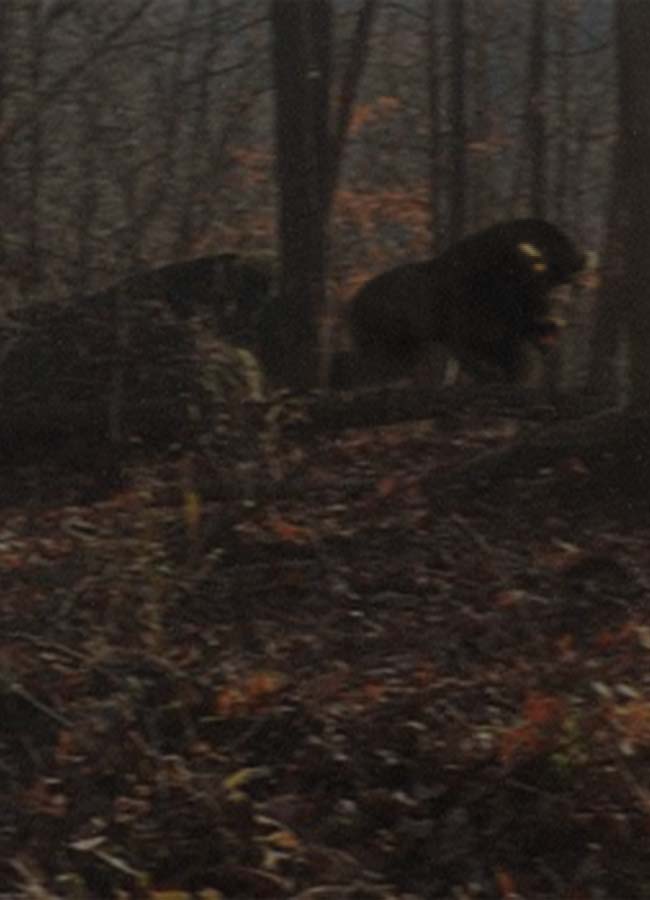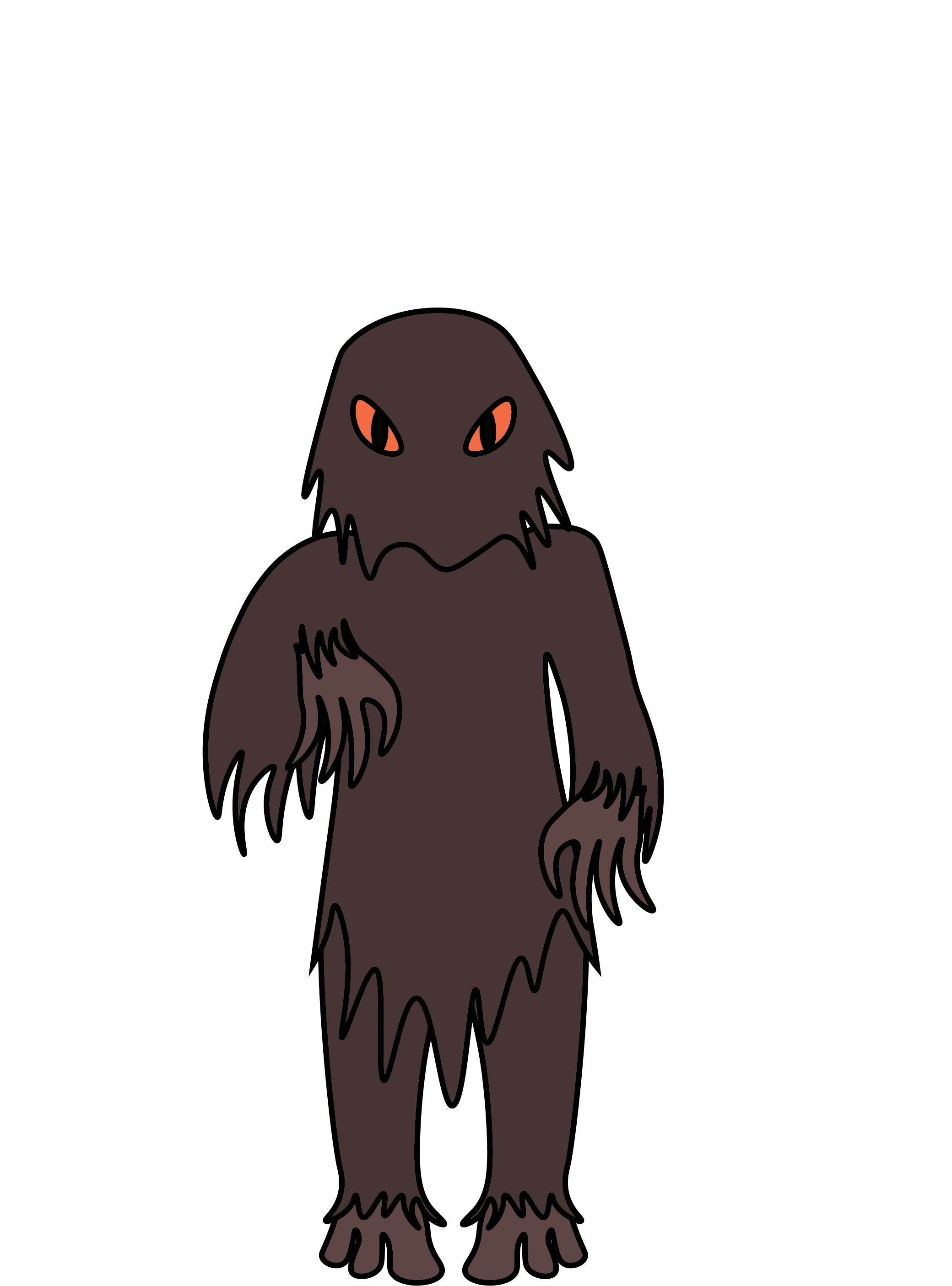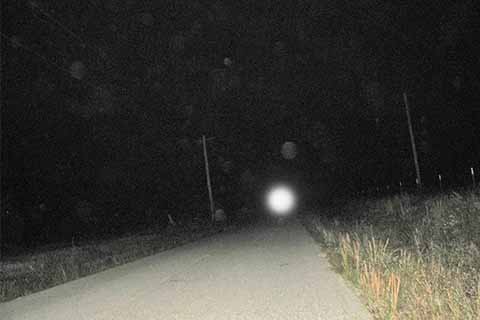 Ozark Howler
Ozark Howler
Aliases: Black Howler, Devil Cat, Booger Cat, Wampus Cat, Bearcat, Nightshade Bear, Hoo-Hoo
Description: Often described as a stocky nocturnal beast (usually feline in appearance, though canine features have been reported) the size of a bear, with shaggy black fur, red eyes, and large horns. Its cry has been described as a mix between a wolf’s howl and the bugle of an elk, though it has also been said to laugh like a hyena or let out a humanlike scream. This namesake cry is said to carry for miles.
Legend: Tales of the Howler have posited that it is a guardian land spirit or the manifestation of a witch’s curse. It is said to be an omen of misfortune or death, with some reports recounting aggressive behaviour. Daniel Boone is said to have encountered the Howler and shot at it; accounts vary as to whether he struck and killed it.
Sightings: The Howler has been seen in the Ozarks at least as far back as the 1800s. The most recent reported sightings were in the late 2010s.
Possible Explanations: Red wolf, mountain lion, lynx, bear, rediscovered ancient cat, hybrid canid, feral dog, surviving creodont lineage, individual of a known species with genetic abnormalities or tumorous growths upon the head, offshoot of the mythology of the Cù-sìth (Black Dog) brought by settlers from the British Isles and possibly combined with Indigenous lore

 MoMo
MoMo
Aliases: The Missouri Monster
Description: A seven-foot-tall, shaggy, apelike biped. It has a pumpkin-shaped head and emits a foul odor. It has been described as having glowing red or orange eyes, three toes on each foot, and being fully covered in hair.
Legend: On July 11, 1972, two boys in Louisiana, Missouri were playing in their backyard when they came face-to-face with the creature, which was carrying what seemed to be a dead dog. Their sister, hearing their screams from within the house, looked out the kitchen window and also saw it (no one was harmed). Several other sightings in Louisiana (MO) were reported that year, notably an encounter reported by a member of the city council, who caught it in his headlights as he was driving along a dry creek bed. Although a posse was formed to track MoMo down, they were unsuccessful. Some believe that if MoMo exists, it is a member of a small, reclusive population of bigfoot-like native cryptid.
Sightings: The 1972 sightings are the most well-known, though there have been sporadic reports since.
Possible Explanations: Teenage pranksters, an offshoot of the Bigfoot mythos

 Joplin Spooklight
Joplin Spooklight
Aliases: Hornet Spooklight, Tri-State Spooklight, Hollis Spooklight
Description: A glowing orange light (or lights) that appears in the evening or nighttime hours along a four-mile stretch of dirt road between Oklahoma and Missouri. (This road has become known as Spook Light Road”, or “The Devil’s Promenade near Quapaw, Oklahoma”. The light travels east to west, though its speed, size, height and patterns of movement vary. It seems to avoid large crowds and loud noises.
Legend: There are several legends explaining the origin of the Spooklight. One of the oldest states that the light is the spirit of a murdered Osage chief who died in the area. Another says that the Light(s) are the ghosts of a young Quapaw woman who married against her father’s wishes. Pursued by their tribe’s warriors, the lovers jumped from a cliff above the Spring River, to remain together forever in death. A third legend says that the spirit is instead a miner who returned home to find his cabin burned down and his family missing, and that he continues to search for them by the light of his lantern.
Sightings: Sightings of the Spooklight stretch from the Trail of Tears to the modern day.
Possible Explanations: Reflected light from headlights or billboards, swamp gas, atmospheric discharges

Other Ozark Cryptids
Gowrow
The gowrow is a large reptilian beast, twenty feet long, with webbed claws, a blade-tipped tail, tusks, and a line of horns down its back. It is said to hatch from soft-shelled eggs the size of beer kegs, with the young carried in their mother’s pouch.
There are several reports of a gowrow being captured or killed; a posse tracked one beast to its lair after it preyed on the local pets and livestock and were able to bring it down. The remains were supposedly shipped to the Smithsonian, but never arrived. A spelunker in Devil’s Cave supposedly ran into a gowrow; another was captured after a man tricked it into eating so many dried apples it swelled up and was unable to escape into its burrow. It is said that he exhibited it for twenty-five cents a person, until it escaped during a show.
Snawfus
A creature that bears resemblance to a large white deer, with blossoming plum or dogwood branches growing in place of antlers. It is said that it exhales the blue mist that settles over the Ozark mountains in the autumn and winter months, and it possesses the ability to take flight, leaping among the branches of the trees.
Two tales explain its origin; in one, an orchardist caught the snawfus and grafted scions of the Arkansas black apple to its antlers. In the other, a hunter, having run out of bullets, shot an albino deer with plum pits, the animal getting up and running away despite taking the makeshift ammunition to its head. The hunter later heard stories of a white buck with plum trees in place of its antlers.
To see an albino deer is an ill omen. To see the snawfus is to see your imminent death.
Gollywog
Described as a giant mudpuppy (or waterdog, in Ozarks slang), the gollywog is known mostly as a mischief maker, known for tangling nets, destroying tackle, and capsizing fishing boats. Reports state that this salamander may reach lengths of eight to ten feet from nose to tail.
Hide-Behind
Never directly seen, the hide-behind is described as a large, powerful animal that stalks those who wander the woods. Whenever someone tries to look at it, it quickly conceals itself behind an object or its would-be observer. The hide-behind is an ambush predator, dining upon the intestines of its victims, though it is said to have a strong aversion to alcoholic, which can thus be used as a repellant.
Unexplained sounds in the night are attributed to the hide-behind, as have been the disappearances of loggers, lumberjacks, and others who venture into the forests and never return.
References
https://www.news-leader.com/story/sports/outdoors/2015/12/15/johnson-do-you-believe-ozark-howler/77357078/?fbclid=IwAR0fIusTx8b23IbXGY2mZcSRtJm0q7Cq77YsIema4dkHCzrOkm_gGtxLw8A
https://ozarkhowler.com/
https://cryptidz.fandom.com/wiki/Ozark_Howler
https://www.reddit.com/r/Cryptozoology/comments/znzh7l/the_ozark_howler_a_midwestern_folktale/?rdt=61189
https://417escapeartist.com/living-legend-the-ozark-howler/
https://ozarkhowler.home.blog/2019/01/13/avoiding-pseudoscientific-just-so-stories-of-the-ozark-howler/
https://www.columbiamissourian.com/news/40-years-later-debate-over-momo-lingers/article_d303bb01-2652-576f-a25e-31179d5a02d7.html
What is this?
For Missouri State University ART 300
Mason: Producer, video editor
Carson: Audio engineer
Katherine: Researcher, GIF expert, 3D modeler
autumn: Web designer